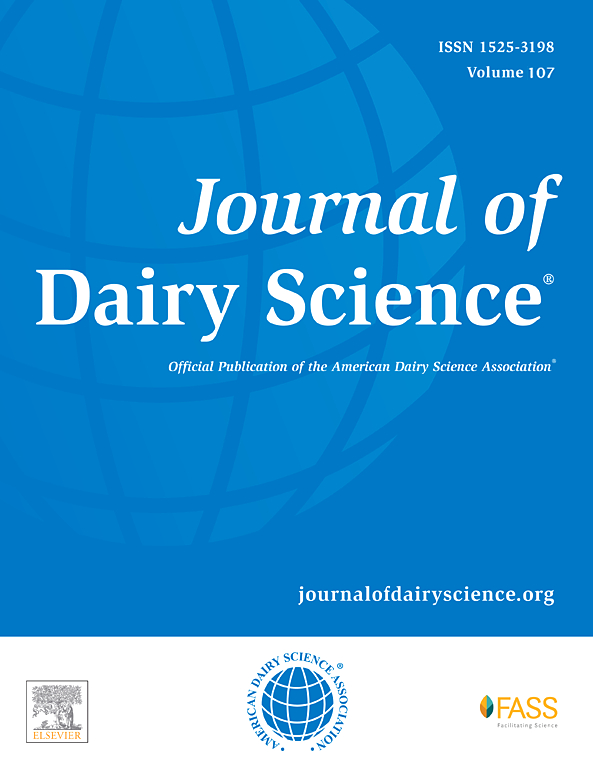Enrichment of pasteurized skim milk with grape seed oil multilayer emulsions: Investigating the effect of emulsion layers on physicochemical, microbial, and sensory characteristics
IF 3.7
1区 农林科学
Q1 AGRICULTURE, DAIRY & ANIMAL SCIENCE
引用次数: 0
Abstract
Cow milk is a nutritionally valuable food, although it lacks essential UFA. Enriching milk with these fatty acids can reduce risks associated with cholesterol and saturated fats while meeting consumers' dietary needs. Grape seed oil (GSO), which is rich in n-6 and n-9 fatty acids, is one potential additive to replace milk fat and increase the unsaturated fat content. However, these essential UFA are hydrophobic, making them difficult to dissolve in water, and are prone to oxidation, which can negatively affect the aroma and flavor of the milk. The layer-by-layer emulsion method is a promising approach to mitigate these challenges. This study investigated the enrichment of pasteurized skim milk with optimized multilayer emulsions of GSO and evaluated the physicochemical, microbial, and sensory characteristics of the milk over a storage period of 7 d at 4°C. Results indicated that single- and triple-layer emulsions remained stable within the milk matrix, but the 2-layer emulsion became unstable by d 3 of storage. During storage, acidity increased in all samples (from 0.16 to 0.44, 0.24 to 0.48, and 0.2 to 0.36 for single-, double-, and triple-layer emulsions, respectively), as did viscosity (from 1.53 to 1.9, 1.55 to 2.2, and 1.46 to 1.78 mPa·s, respectively), total microorganism count, peroxide value (from 5.52 to 17.6, 4.7 to 19.38, and 3.09 to 10.3 mEq/kg oil, respectively), and thiobarbituric acid index (from 0.43 to 0.52, 0.44 to 0.63, and 0.39 to 0.47 mg malondialdehyde/kg of oil, respectively). The pH values decreased slightly across all samples (from 6.6 to 6.5). No mold, yeast, or coliforms were detected in any sample throughout the study. Overall, the use of bioactive compounds such as essential fatty acids through milk enrichment can greatly enhance the quality of widely consumed dairy products.
用葡萄籽油多层乳剂富集巴氏脱脂奶:研究乳剂层对理化、微生物和感官特性的影响。
牛奶是一种营养价值很高的食物,尽管它缺乏必需的不饱和脂肪酸。在牛奶中添加这些脂肪酸可以降低与胆固醇和饱和脂肪相关的风险,同时满足消费者的饮食需求。葡萄籽油(GSO)富含-6和-9脂肪酸,是一种潜在的替代乳脂和增加不饱和脂肪含量的添加剂。然而,这些必需的不饱和脂肪酸是疏水性的,很难溶于水,而且容易氧化,会对牛奶的香气和风味产生负面影响。逐层乳化法是一种很有希望缓解这些挑战的方法。本研究研究了优化的多层GSO乳剂对巴氏脱脂牛奶的富集,并评估了牛奶在4°C下储存7天的理化、微生物和感官特性。结果表明,单层和三层乳剂在乳基质中保持稳定,而两层乳剂在3 d后变得不稳定。在存储期间,酸度增加在所有样本(从0.16到0.44,0.24,0.48,0.2到0.36的单,双,三层乳剂,分别),粘度一样(从1.53到1.9,1.55,2.2,1.46到1.78 mPa·s,分别),微生物总数,过氧化值(从5.52到17.6,4.7,19.38,3.09到10.3毫克当量/公斤油,分别),和硫代巴比土酸指数(从0.43到0.52,0.44,0.63,0.39到0.47毫克丙二醛/公斤的油,分别)。所有样品的pH值都略有下降(从6.6降至6.5)。在整个研究过程中,没有在任何样品中检测到霉菌,酵母或大肠菌。总的来说,利用生物活性化合物,如必需脂肪酸,通过牛奶浓缩可以大大提高广泛消费的乳制品的质量。
本文章由计算机程序翻译,如有差异,请以英文原文为准。
求助全文
约1分钟内获得全文
求助全文
来源期刊

Journal of Dairy Science
农林科学-奶制品与动物科学
CiteScore
7.90
自引率
17.10%
发文量
784
审稿时长
4.2 months
期刊介绍:
The official journal of the American Dairy Science Association®, Journal of Dairy Science® (JDS) is the leading peer-reviewed general dairy research journal in the world. JDS readers represent education, industry, and government agencies in more than 70 countries with interests in biochemistry, breeding, economics, engineering, environment, food science, genetics, microbiology, nutrition, pathology, physiology, processing, public health, quality assurance, and sanitation.
 求助内容:
求助内容: 应助结果提醒方式:
应助结果提醒方式:


